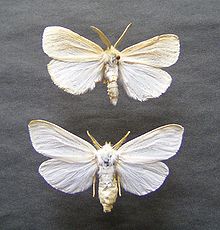bio.wikisort.org - Animal
Laelia coenosa, the reed tussock, is a moth of the family Erebidae. The species was first described by Jacob Hübner in 1808. It is found in North Africa, southern and central Europe, through Russia and eastern Asia up to Japan.

| Reed tussock | |
|---|---|
 | |
| Male (top), female (bottom) | |
| Scientific classification | |
| Kingdom: | Animalia |
| Phylum: | Arthropoda |
| Class: | Insecta |
| Order: | Lepidoptera |
| Superfamily: | Noctuoidea |
| Family: | Erebidae |
| Genus: | Laelia |
| Species: | L. coenosa |
| Binomial name | |
| Laelia coenosa (Hübner, 1808) | |
The wingspan is 35–50 mm. In the male the forewings are whitish ochreous, brownish tinged, especially towards the costa. There is a very indistinct fuscous discal dot and a posterior series of several fuscous dots between veins. The hindwings are whitish, towards apex brownish tinged. In the female the forewings and hindwings are whitish. Larva blackish, hairs yellowish; pencils on 2 and 12 brownish or blackish, tufts on 5 through 8 yellowish.[1]
The larvae primarily feed on Phragmites australis and Phragmites communis, but also Festuca, Carex and Cladium species. The moth flies from July to August depending on the location.
References
- Meyrick, E. (1895). A Handbook of British Lepidoptera. MacMillan, London.
 This article incorporates text from this source, which is in the public domain.
This article incorporates text from this source, which is in the public domain.
External links
- Kimber, Ian. "72.014 BF2024 Reed Tussock Laelia coenosa (Hübner, [1808])". UKMoths. Retrieved 15 May 2020.
- Mazzei, Paolo; Morel, Daniel & Panfili, Raniero. "Laelia coenosa (Hübner, [1808])". Moths and Butterflies of Europe and North Africa. Retrieved 15 May 2020.
- "Laelia coenosa (Hübner, 1808)". Fauna Europaea. Retrieved 15 May 2020.
- "10410 Laelia coenosa (Hübner, [1808]) - Schilf-Bürstenspinner, Gelbbein". Lepiforum e. V. Retrieved 15 May 2020.
 Media related to Laelia coenosa at Wikimedia Commons
Media related to Laelia coenosa at Wikimedia Commons Data related to Laelia coenosa at Wikispecies
Data related to Laelia coenosa at Wikispecies
Другой контент может иметь иную лицензию. Перед использованием материалов сайта WikiSort.org внимательно изучите правила лицензирования конкретных элементов наполнения сайта.
WikiSort.org - проект по пересортировке и дополнению контента Википедии